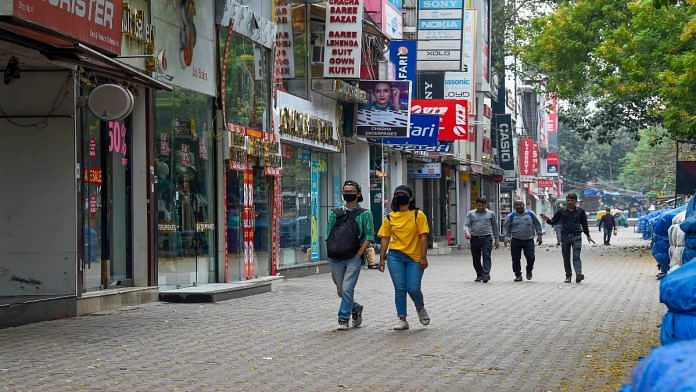India is reeling from a quadruple whammy that is practically unique even during this pandemic. First, growth has taken a hit that appears to be larger than any of its peers, with GDP shrinking 23.9% in the first post-pandemic quarter. While the economy has re-opened somewhat since then, it remains beset by supply constraints. That means — second — that inflation may have reached almost 7%, according to Bloomberg Economics’ Abhishek Gupta.
That’s well out of the Reserve Bank of India’s comfort zone. And, third, all this has hit an economy that was already suffering from slipping potential growth and a major tax revenue crisis following the underperformance of a national goods-and-services tax.
India might still have managed this economic storm if its Covid-19 case total was not exploding as well. The country is now registering over 83,000 new cases a day. Most nations across the world have successfully moved off the peak of their infection curves; in India, on the other hand, new daily records are still being set.
It’s now likely that the pandemic has, as feared, moved out of urban areas into India’s vast, and crowded, rural hinterland. Here, health services will be far less equipped for a surge in cases — and a distant state machinery itself may not know of localized outbreaks till it is too late.
The government, faced with a crashing economy and with its cupboards completely bare, has no real way to directly improve the welfare of those most affected. Programs like Britain’s furlough scheme or the U.S.’s $600 per week unemployment aid are a distant dream in India. Even if the government had the money — which, thanks to its tax botch-up, it does not — it couldn’t be sure of getting it to the people in need.
So, as far as officials are concerned, the only way to get people back on their feet is to gradually lift pandemic-related restrictions. That is precisely what is happening: Restrictions are being removed without any consideration for the increasing caseload and with minimal information about possible infection clusters.
Strangely, there’s very little panic in India, either among policymakers or the public in general. Perhaps that’s because the case fatality rate, as far as the government can tell, is well below 2% and thus among the lowest in the world.
We don’t know why — are we missing cases, as the Lancet suggests? India is increasingly using buggy antigen tests, so that is certainly a possibility. It’s also possible that Covid-related deaths aren’t being recorded as such.
While there are no signs yet that the health system is overloaded, it may be getting there. Delhi’s most prestigious state-run hospital recently tried to shut down all outpatient work to focus on hospitalizations. In any case, climbing case rates will inevitably increase the stress on India’s inadequate health systems. So it’s entirely possible that the case fatality rate may also, tragically, increase.
Worryingly, the drumbeat for a big “stimulus” has begun. Pressure is growing on the finance ministry — which has so far been impressively careful — to start shelling out more cash to business. Some sectoral associations have even gone to the Supreme Court demanding the judges ensure they don’t have to pay interest on their loans.
The fact is, however, that a “second stimulus” — especially one directed at business — would be fiscally dangerous. It would also be wasted money, because neither consumer nor business sentiment is going to revive while case numbers are growing so fast. Everyone can see the curve and nobody knows how bad it may still get.
Meanwhile, as the Delhi hospital’s attempt to cut off routine health services indicates, the silent costs of the pandemic are building up. The immunization program, for example, has essentially been halted, which means that a generation of children will be particularly vulnerable to communicable diseases such as measles.
Millions of kids who already receive an education that is not up to global standards cannot go to school. And, unlike in the West, only a quarter of students in India can access online classes. Given that this generation is the one that will have to take India’s last shot at prosperity, that’s especially bad news.
India won’t get a proper sense of the extent of these silent costs for some time, certainly not before next year. The finance ministry and the government more broadly should resist calls to spend money now that it does not have. It’s going to need that ammunition even more soon. – Bloomberg
Also read: Worst over for Indian economy, country to see V-shaped recovery, says finance ministry







Nice article. We have been in the field continuosly working right from day one of Lockdown. I am glad the lockdown was removed. Have been eating out at dhabas, Hotels since beginning. I have continued using housemaid since day one. But have always taken full preventive measures using face mask, sanitiser , drinking hot water and Always washed hand. Took covid patients to hospital. But We have been lucky till now that the COVID in India is milder. And have seen many colleagues getting COVID but still have not understood how they contacted it and from whom. A few had to be admitted to hospital. In Rural people do not follow preventive measures..So it is risky for them. However Indians follow many homemade remedies such as Kadha , Milk and turmeric which kill viruses specially of the throat and respiratory tract. The lockdown was not implemented in Rural . But still they managed well.
Waiting for the Vaccine. It’s needed mostly for economic reasons. Health wise India is fine. But the economic activities have reduced and this will hurt more than the COVID itself.
A to-the-point comprehensive article – so rare these days. Thank you Sharmaji.